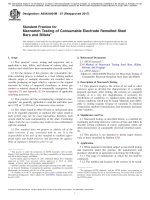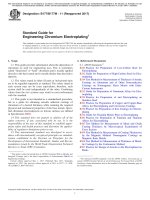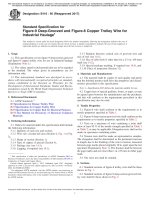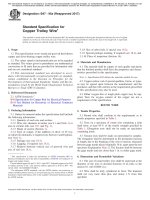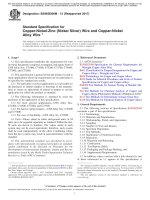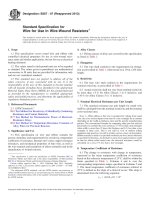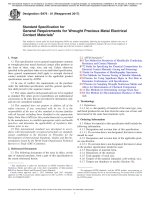Astm b 286 07 (2017)
Bạn đang xem bản rút gọn của tài liệu. Xem và tải ngay bản đầy đủ của tài liệu tại đây (105.44 KB, 5 trang )
This international standard was developed in accordance with internationally recognized principles on standardization established in the Decision on Principles for the
Development of International Standards, Guides and Recommendations issued by the World Trade Organization Technical Barriers to Trade (TBT) Committee.
Designation: B286 − 07 (Reapproved 2017)
Standard Specification for
Copper Conductors for Use in Hookup Wire for Electronic
Equipment1
This standard is issued under the fixed designation B286; the number immediately following the designation indicates the year of
original adoption or, in the case of revision, the year of last revision. A number in parentheses indicates the year of last reapproval. A
superscript epsilon (´) indicates an editorial change since the last revision or reapproval.
This standard has been approved for use by agencies of the U.S. Department of Defense.
B355 Specification for Nickel-Coated Soft or Annealed Copper Wire
1. Scope
1.1 This specification covers uninsulated metallic-coated
copper conductors for use in hookup wire for electronic
equipment.
3. Ordering Information
3.1 Orders for material under this specification shall include
the following information:
3.1.1 Quantity of each size, designation (Table 1) and type,
3.1.2 Conductor size, designation, construction, and type
(Table 1).
3.1.3 Whether tin, lead alloy, silver-coated, or nickel-coated
(see 4.1).
3.1.4 For silver-coated conductors and nickel-coated
conductors, class of coating (see 4.1), and when required,
unannealed (see 4.2),
3.1.5 Desired constructions where alternates are given
(Table 1, Type II and, 5.1, 6.1, and 6.2),
3.1.6 Package size (Section 12).
3.1.7 Special package marking if required (Section 11), and
3.1.8 Place of inspection (Section 10).
1.2 The SI values for density are to be regarded as standard.
For all other properties, the inch-pound values are to be
regarded as the standard.
1.3 This international standard was developed in accordance with internationally recognized principles on standardization established in the Decision on Principles for the
Development of International Standards, Guides and Recommendations issued by the World Trade Organization Technical
Barriers to Trade (TBT) Committee.
2. Referenced Documents
2.1 The following documents of the issue in effect on date
of material purchase form a part of this specification to the
extent referenced herein:
2.2 ASTM Standards:2
B33 Specification for Tin-Coated Soft or Annealed Copper
Wire for Electrical Purposes
B189 Specification for Lead-Coated and Lead-Alloy-Coated
Soft Copper Wire for Electrical Purposes
B193 Test Method for Resistivity of Electrical Conductor
Materials
B258 Specification for Nominal Diameters and CrossSectional Areas of AWG Sizes of Solid Round Wires Used
as Electrical Conductors
B298 Specification for Silver-Coated Soft or Annealed Copper Wire
4. General Requirements
4.1 Coating of Wires—The coating of the solid conductors
and the wires composing stranded conductors (before stranding) shall conform to the coating requirements of ASTM
Specifications B33, B189, B298, and B355, as indicated on the
purchase order.
4.2 Temper—Unless otherwise specified, all coated conductors shall be furnished in the annealed temper. When so
specified, silver-coated conductors or nickel-coated conductors
shall be furnished unannealed (Explanatory Note 1).
NOTE 1—The term unannealed as used in this specification means
cold-worked conductor as produced on commercial wire-drawing machines.
4.3 Elongation—The elongation of annealed Type I conductors shall be as specified in Specifications B33, B189, B298,
and B355 as applicable. The elongation of stranded conductors
shall be permitted to vary from the requirements of the
applicable Specifications: B33, B189, B298, and B355 by the
following amounts:
4.3.1 For stranded conductors 22 AWG and smaller, the test
shall be performed on the whole conductor and the elongation
1
This specification is under the jurisdiction of ASTM Committee B01 on
Electrical Conductors and is the direct responsibility of Subcommittee B01.04 on
Conductors of Copper and Copper Alloys.
Current edition approved May 15, 2017. Published May 2017. Originally
approved in 1954. Last previous edition approved in 2012 as B286 – 07 (2012).
DOI: 10.1520/B0286-07R17.
2
For referenced ASTM standards, visit the ASTM website, www.astm.org, or
contact ASTM Customer Service at For Annual Book of ASTM
Standards volume information, refer to the standard’s Document Summary page on
the ASTM website.
Copyright © ASTM International, 100 Barr Harbor Drive, PO Box C700, West Conshohocken, PA 19428-2959. United States
1
2
12–37E
12–19E
14–41
14–19E
16–26
16–19E
18–26E
18–19E
Size
DesignationB
0000–2109
000–1672
00–1330
0–1064
0–1045
1–836
1–817E
2–665
4–133E
4–420
6–133E
6–266
8–133E
8–168
10–105
10–104
10–49E
10–37E
12–65
Size
DesignationB
10380
6530
4110
2580
1620
1020
640
404
253
159
100
10
12
14
16
18
20
22
24
26
28
30
0.0100
0.0100
0.0100
0.0100
0.0100
0.0100
0.0100
0.0100
0.0179
0.0100
0.0142
0.0100
0.0113
0.0100
1.0100
0.0100
0.0142
0.0159
0.0100
Number
of WiresC
2109F
1672F
1330F
1064F
1045F
836F
817F
665F
133F
420G
133F
266G
133F
168G
105G
104H
49G
37E
65H
37E
19J
41H
19J
26H
19J
26H
19J
Number
of WiresC
0.0126
0.0179
0.0100
0.0142
0.0100
0.0113
0.0080
0.0100
Nominal
Diameter of
Each Wire, in.
Conductor Construction
Nominal
Diameter of
Each Wire,
in.
Conductor Construction
Nominal
Area,
cmils
Size
Designation,
AWG
5 874E
6 088E
4 100
3 831E
2 600
2 426E
1 664E
1 900E
Calculated
CrossSectional
Area, cmils
210 900
167 200
133 000
106 400
104 500
83 600
81 700E
66 500
42 615E
42 000
26 818E
26 600
16 983E
16 800
10 500
10 400
9 880G
9 354E
6 500
Calculated
CrossSectional
Area, cmils
0.1019
0.0808
0.0641
0.0508
0.0403
0.0320
0.0253
0.0201
0.0159
0.0126
0.0100
Nominal
Diameter, in.
Maximum
Allowable
Diameter, in.D
0.091
0.093
0.081
0.073
0.062
0.059
0.050
0.052
...
...
...
...
...
...
...
...
...
...
...
...
...
...
1.2 to 1.8
1.7 to 2.1
...
1.10 to 1.75
1.3 to 1.7
0.90
0.90
0.80
0.80
0.60
0.60
0.50
0.50
to
to
to
to
to
to
to
to
1.45
1.45
1.35
1.15
0.90
0.90
0.70
0.70
Length of Lay,
in.
(Explanatory
Note 2)
2.01
1.92
2.94
3.05
4.59
4.82
7.20
6.22
1.05
1.68
2.67
4.27
6.79
10.8
17.3
27.3
43.8
69.4
110.0
Class 2
NickelA
1.17
1.84
2.93
4.65
7.39
11.8
18.8
29.8
47.5
75.4
120.0
Class 10
Nickel
0.0537
0.0677
0.0851
0.106
0.108
0.135
0.139
0.170
0.263
0.270
0.418
0.426
0.661
0.674
1.07
1.08
1.14
1.19
1.73
0.0559(2)
0.0705(2)
0.0887(2)
0.111(2)
0.113(2)
0.141(2)
0.144(2)
0.177(2)
0.274(2)
0.281(2)
0.436(2)
0.443(2)
0.688(2)
0.702(2)
1.11(2)
1.12(2)
1.18(2)
1.24(2)
1.80(2)
50 to 100
µin.
of NickelE
0.0610
0.0770
0.0967
0.121
0.123
0.154
0.158
0.194
0.299
0.306
0.475
0.484
0.751
0.766
1.21
1.23
1.29
1.35
1.96
Class 10
Nickel
1.89
1.81
2.74
2.87
4.27
4.54
6.71
5.79
Annealed
Silver
Coated
1.97(2)
1.88(2)
2.85(2)
2.99(2)
4.45(2)
4.73(2)
7.14(4)
6.03(2)
50 to 100 µin.
of NickelI
2.15
2.05
3.11
3.26
4.86
5.15
7.63
6.58
Class 10
Nickel
D-C Resistance at 20°C, Ω/1000 ft, max (Explanatory Note 2)
0.0576
0.0727
0.0914
0.114
0.116
0.145
0.149
0.183
0.280
0.289
0.444
0.457
0.701
0.724
1.15
1.16
1.21
1.26
1.85
Annealed
Silver
Coated
2.66
2.55
3.85
4.05
6.02
6.39
9.45
8.16
Class 27
Nickel
0.0756
0.0954
0.120
0.150
0.153
0.191
0.195
0.240
0.371
0.380
0.589
0.600
0.930
0.949
1.50
1.52
1.60
1.67
2.43
Class 27
Nickel
1.44
2.28
3.63
5.77
9.17
14.6
23.3
36.9
58.9
107.0
149.0
Class 27
Nickel
D-C Resistance at 20°C, Ω/1000 ft, max (Explanatory Note 2)
Annealed
Tin or
Lead-Alloy
Coated
1.02
1.62
2.58
4.10
6.52
10.3
16.5
26.2
41.9
66.8
106.0
Annealed
Silver
Coated
Annealed
Tin or
Lead-Alloy
Coated
Type II (Stranded Conductors)
0.635
0.545
0.486
0.435
0.431
0.386
0.382
0.342
0.274
0.275
0.217
0.220
0.173
0.177
0.130
0.130
0.132
0.115
0.099
Maximum
Allowable
Diameter, in.D
Length of Lay,
in.
(Explanatory
Note 3)
Type II (Stranded Conductors)
1.06
1.69
2.68
4.26
6.78
10.7
17.2
27.2
44.5
70.8
114.0
Annealed Tin or
Lead-Alloy Coated
D-C Resistance at 20°C, Ω/1000 ft, max (Explanatory Note 2)
Type I (Solid Conductors)
TABLE 1 Details of Conductor Construction
B286 − 07 (2017)
3
7J
10J
10H
7J
19J
7J
19J
7J
19J
7J
19J
7J
7J
7J
Number
of WiresC
0.0159
0.0080
0.0100
0.0126
0.0063
0.0100
0.0050
0.0080
0.0040
0.0063
0.0031
0.0050
0.0040
0.0031
Nominal
Diameter of
Each Wire, in.
1 770E
1 216E
1 000
1 111E
754E
700E
475E
448E
304E
278E
183E
175E
112E
67g
Calculated
CrossSectional
Area, cmils
Maximum
Allowable
Diameter, in.D
0.050
0.042
0.040
0.039
0.033
0.031
0.027
0.025
0.022
0.020
0.017
0.016
0.013
0.011
Continued
0.50
0.45
0.45
0.45
0.25
0.25
0.25
0.25
0.25
0.25
0.25
0.25
0.25
0.10
to
to
to
to
to
to
to
to
to
to
to
to
to
to
0.70
0.55
0.55
0.55
0.43
0.43
0.35
0.35
0.30
0.30
0.30
0.30
0.30
0.30
Length of Lay,
in.
(Explanatory
Note 2)
6.54
9.76
11.8
10.4
15.9
16.7
25.4
26.2
40.1
42.6
67.7
68.2
108.0
182.0
Annealed
Tin or
Lead-Alloy
Coated
6.16
9.10
11.0
9.81
14.8
15.6
23.6
24.5
37.3
39.7
63.1
63.6
100.0
170.0
Annealed
Silver
Coated
6.42(2)
9.68(4)
11.5(2)
10.2(2)
15.7(4)
16.2(2)
25.2(4)
26.0(4)
41.0(7)
42.2(4)
69.3(7)
67.6(4)
110.0(7)
186.0(7)
50 to 100 µin.
of NickelI
7.00
10.3
12.5
11.1
16.8
17.7
26.9
27.8
42.4
45.1
71.7
72.2
114.0
193.0
Class 10
Nickel
D-C Resistance at 20°C, Ω/1000 ft, max (Explanatory Note 2)
8.67
12.8
15.5
13.8
20.8
21.9
33.3
34.4
52.6
55.9
88.8
89.5
141.0
239.0
Class 27
Nickel
B
Provides minimum of 50 µin. of nickel.
These size designations are solely for purposes of identification. They should not be confused with AWG sizes.
C
The stranded conductor constructions shown in this table provide for finished noninsulated conductors having the indicated cross-sectional area. The number of component wires may vary slightly provided the specified
resistances are not exceeded.
D
The maximum allowable diameters of these conductors are given here for guidance in making calculations regarded insulating material, etc. These diameters do not include allowance for distortion of the conductor
during stranding and are not intended to be used as limiting values.
E
The cross-sectional areas of these conductor-size designations deviate by more than 2 per cent from the nominal areas of the standard AWG sizes as defined in Specification B258.
F
Nineteen member ropes.
G
Seven member ropes.
H
Bunch-stranded.
I
The numbers in parentheses indicate the class of nickel coating required to meet resistance values tabulated. These classes appear in Specification B355.
J
Concentric-stranded.
†Editorially corrected.
A
18–7E
20–19E
20–19†
20–7E
22–19E
22–7E
24–19E
24–7E
26–19E
26–7E
28–19E
28–7E
30–7E
32–7E
Size
DesignationB
Conductor Construction
TABLE 1
Type II (Stranded Conductors)
B286 − 07 (2017)
B286 − 07 (2017)
be such that the diameter, configuration, conductor resistance,
flexibility, and mechanical strength are not substantially affected.
measured when the first strand of the conductor breaks. The
minimum average elongation shall not be less than 10 % with
no individual specimen less than 5 %.
4.3.2 For stranded conductors larger than 22 AWG, strands
shall be carefully removed from the conductor and tested for
elongation. The minimum average elongation shall not be less
than 10 % with no individual strand less than 5 %.
8. Physical and Electrical Tests
8.1 Tests to determine conformance of the coating to the
requirements of Specifications B33, B189, B298, or B355 shall
be performed on Type I conductors before insulating and on the
individual wires of Type II conductors before stranding.
4.4 D-C Resistance—The d-c resistance in ohms per 1000 ft
of annealed solid and stranded conductor shall not exceed,
before insulating, the appropriate values prescribed in Table 1
(Explanatory Note 2).
8.2 Tests to determine conformance to the elongation requirements prescribed in 4.3 shall be made before insulating.
8.3 Tests to determine conformance to the electrical resistance requirements prescribed in Table 1 shall be made on the
uninsulated conductor in accordance with Test Method B193
(Explanatory Note 2).
5. Conductor Construction
5.1 Solid conductors shall conform to the requirements for
Type I conductors prescribed in Table 1.
5.2 Stranded conductors shall conform to the requirements
for Type II conductors prescribed in Table 1. The method of
stranding for conductor size designations 32-7 through 10-104
inclusive shall be at the option of the manufacturer unless
otherwise specified. Stranded conductors size designation 10105 and larger shall normally be furnished in a rope-laystranded construction consisting of either 7 or 19 bunchstranded members.
8.4 Examination for Workmanship of Finished Uninsulated
Stranded Conductor—A visual inspection with the unaided eye
shall be performed on the outer layer of the conductor on the
supplied package. Use a white card (as a background) to
ascertain if any base metal is exposed through a break in the
coating. Detection of any base metal constitutes rejection.
8.5 Examination for Workmanship of Finished Uninsulated
Stranded Conductor—A visual inspection with 10X magnification and with a white background shall be performed on a
conductor sample taken from the top of the supplied spool. The
sample shall be a minimum of 12 in. (30 cm) in length. The
outer surface of all stranded constructions shall be examined.
Detection of excessive exposed base metal due to the
stranding process, such as indications along one side of the
sample due to excessive localized abrasion during stranding,
constitutes rejection. Continuous lines or patterns of exposed
base metals constitute rejection. Small random point failures
shall not be cause for rejection.
6. Lay of Stranded Conductors
6.1 The direction of lay of the outside layer of stranded
conductors shall be left-hand. The direction of lay of the
bunch-stranded members composing rope-lay-stranded conductors shall be at the option of the manufacturer unless
otherwise specified.
6.2 The direction of lay of the outer layer of rope-laystranded conductors shall be lefthand. The direction of lay of
the other layers shall be reversed in successive layers, unless
otherwise specified.
9. Density
6.3 The length of lay of the outside layer of stranded
conductors in size designation 32-7 through 10-104, inclusive,
shall conform to the values in Table 1 (Explanatory Note 3).
For strand constructions containing more than one distinct
layer the length of lay of the inner layer shall not exceed the
maximum value shown in Table 1 for the conductor in
question. For rope-lay-stranded conductors size designation
10-105 and larger, and size 49/0.0142, the length of lay of the
wires composing the bunch-stranded members shall be not
more than 30 times the diameter of the member, and the length
of lay of the outer layer of rope-lay-stranded conductors shall
be not less than 8 nor more than 16 times the outside diameter
of the completed conductor.
9.1 For the purpose of calculating mass, cross-sectional
area, etc., the density of the coated copper shall be taken as
8.89 g/cm3 (0.32117 lb/in.3) at 20°C (Explanatory Note 5).
10. Inspection
10.1 All tests and inspection shall be made at the place of
manufacture unless otherwise especially agreed upon by the
manufacturer and the purchaser at the time of purchase. The
manufacturer shall afford the inspector representing the purchaser all reasonable facilities, without charge, to satisfy him
that the material is being furnished in accordance with this
specification.
11. Product Marking
7. Joints
11.1 The net mass, length (or lengths, and number of
lengths, if more than one length is included in the package),
size designation, type of conductor, purchase order number,
and any other marks required by the purchase order shall be
marked on a tag attached to the end of the conductor inside of
the package. The same information, together with the manufacturer’s serial number (if any) and all shipping marks
required by the purchaser, shall appear on the outside of each
package.
7.1 Necessary joints in the individual wires of conductors
size designation 32-7 through size designation 10-104,
inclusive, may be silver soldered, brazed, or butt welded.
(Explanatory Note 4). Bunch-stranded members composing
ropelay-stranded conductors may be joined as a unit by brazing
and these joints shall be at least two lay lengths apart and be
finished off so that the conductor diameter is not increased at
the joint. Disposition of joints throughout the conductor shall
4
B286 − 07 (2017)
12. Packing and Package Marking
13. Keywords
12.1 Package sizes for conductors shall be agreed upon by
the manufacturer and the purchaser in the placing of individual
orders.
13.1 copper hookup wire; electronic equipment hookup
wire; electronic hookup wire; hookup wire
12.2 The conductors shall be protected against damage in
ordinary handling and shipping.
EXPLANATORY NOTES
NOTE 1—Unannealed silver-coated conductors or nickel-coated conductors should be used only when the insulating process will produce an
annealed insulated conductor.
NOTE 2—Because of the difficulties encountered in determining correctly the cross-sectional area of stranded conductors, this requirement has
been superseded by a d-c ohmic resistance per 1000-ft length of
conductor. Since this specification described uninsulated conductors
intended for ultimate use as insulated conductors in various electronic
devices, maximum resistance values are shown for the conductors before
insulating to serve as the minimum acceptance requirement for the
conductor. In order that all commercial or other specifications for finished
insulated conductors which may be derived from this basic specification
be uniform as to the resistance requirements of the insulated product, it is
recommended that values for size designations 0000-2109 through 18-7 be
used as maximum resistance requirements for the conductors in the
finished insulated product. For size designations 20-19 through 32-7, some
increase of resistance may occur during the insulating process due to
stretching so that an allowance in the maximum resistance requirement is
recommended. The values appearing in Table 1 under the heading
“Annealed Silver Coated” are applicable to silver-coated conductors
whether annealed or unannealed prior to insulating.
The method used to calculate the values appearing in Table 1 is shown
below:
D-C Resistance at 20°C for the Bare Conductors (Table 1):
Maximum ohms per 1000 ft = 10.371 K/(1000 NC × d 2f )
where:
K = stranding factor as follows:
Annealed tin or lead-alloy coated up to 0.0110, incl
0.9315
over 0.0110 to 0.0200, incl 0.9416
over 0.0200
0.9616
Annealed nickel coated, Class 2
all
0.96
Annealed nickel coated, Class 4
all
0.94
Annealed nickel coated, Class 7
all
0.91
Annealed nickel coated, Class 10
all
0.88
Annealed nickel coated, Class 27
all
0.71
d = single wire and strand diameter as follows:
For wire and strand 0.0100 in. and larger, except nickel-coated over 0.0508 in.,
use nominal diameter in inches.
For nickel-coated wire over 0.0508 in., use nominal wire diameter in inches less
0.0005 in.
For strand under 0.0100 in., use nominal diameter in inches less 0.0001 in.
f = diameter factor (allowance for min dia).
Wire and strand 0.0100 in. and larger, except nickel coated over
0.0508 in.
Nickel-coated wire over 0.0508 in.
Strand under 0.0100 in.
Annealed silver coated
Range of
Wire Sizes, in.
all
1.00
1.00
NOTE 3—The peculiarities of the applications for which these stranded
conductors are used require some degree of flexibility along with the
characteristic that the wires of the conductor shall not untwist or fray when
the insulation is stripped to make soldered or other joints in the electronic
devices. To accomplish this requires that the conductor be stranded with
a shorter lay than is normally permitted in conductors for flexible cords.
NOTE 4—Though joints in stranded conductors as a whole are not
recognized in this specification, it is intended that with certain types of
stranding equipment, these joints may be necessary to provide for
economical insulating operations. When by mutual agreement between the
manufacturer and the purchaser such joints are used, they shall be
conspicuously marked, and removed from the conductor at the final
insulating operation.
NOTE 5—The value of density of copper is in accordance with the
International Annealed Copper Standard. The corresponding value at 0°C
(32°F) is 8.90 g/cm3 (0.32150 lb/in.3). In calculations involving density it
must be borne in mind that the apparent density of coated wire is not a
constant but a variable function of wire diameter. The smaller the diameter
the greater the percentage of coating present and hence the greater
departure from the density of copper.
Number of Strands
Factor
1
1.00
7
1.03
up through
19
1.04
up through
37
1.05
up through
133
1.06
over
133
1.07
N = number of strands in the conductor.
C = minimum wire conductivity divided by 100 as shown in the following table:
Type of Wire
f
0.98
C
1.00
ASTM International takes no position respecting the validity of any patent rights asserted in connection with any item mentioned
in this standard. Users of this standard are expressly advised that determination of the validity of any such patent rights, and the risk
of infringement of such rights, are entirely their own responsibility.
This standard is subject to revision at any time by the responsible technical committee and must be reviewed every five years and
if not revised, either reapproved or withdrawn. Your comments are invited either for revision of this standard or for additional standards
and should be addressed to ASTM International Headquarters. Your comments will receive careful consideration at a meeting of the
responsible technical committee, which you may attend. If you feel that your comments have not received a fair hearing you should
make your views known to the ASTM Committee on Standards, at the address shown below.
This standard is copyrighted by ASTM International, 100 Barr Harbor Drive, PO Box C700, West Conshohocken, PA 19428-2959,
United States. Individual reprints (single or multiple copies) of this standard may be obtained by contacting ASTM at the above
address or at 610-832-9585 (phone), 610-832-9555 (fax), or (e-mail); or through the ASTM website
(www.astm.org). Permission rights to photocopy the standard may also be secured from the Copyright Clearance Center, 222
Rosewood Drive, Danvers, MA 01923, Tel: (978) 646-2600; />
5
